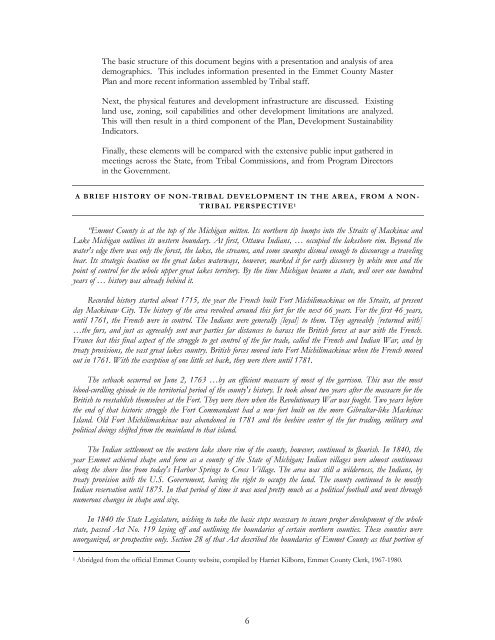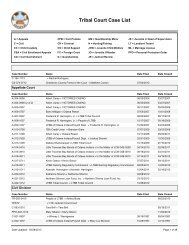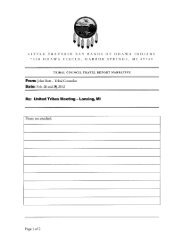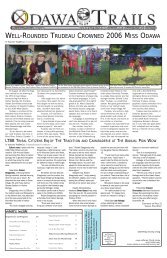LTBB Master Land Use Plan - Little Traverse Bay Bands of Odawa ...
LTBB Master Land Use Plan - Little Traverse Bay Bands of Odawa ...
LTBB Master Land Use Plan - Little Traverse Bay Bands of Odawa ...
You also want an ePaper? Increase the reach of your titles
YUMPU automatically turns print PDFs into web optimized ePapers that Google loves.
The basic structure <strong>of</strong> this document begins with a presentation and analysis <strong>of</strong> area<br />
demographics. This includes information presented in the Emmet County <strong>Master</strong><br />
<strong>Plan</strong> and more recent information assembled by Tribal staff.<br />
Next, the physical features and development infrastructure are discussed. Existing<br />
land use, zoning, soil capabilities and other development limitations are analyzed.<br />
This will then result in a third component <strong>of</strong> the <strong>Plan</strong>, Development Sustainability<br />
Indicators.<br />
Finally, these elements will be compared with the extensive public input gathered in<br />
meetings across the State, from Tribal Commissions, and from Program Directors<br />
in the Government.<br />
A BRIEF HISTORY OF NON-TRIBAL DEVELOPMENT IN THE AREA, FROM A NON-<br />
TRIBAL PERSPECTIVE 1<br />
“Emmet County is at the top <strong>of</strong> the Michigan mitten. Its northern tip bumps into the Straits <strong>of</strong> Mackinac and<br />
Lake Michigan outlines its western boundary. At first, Ottawa Indians, … occupied the lakeshore rim. Beyond the<br />
water's edge there was only the forest, the lakes, the streams, and some swamps dismal enough to discourage a traveling<br />
bear. Its strategic location on the great lakes waterways, however, marked it for early discovery by white men and the<br />
point <strong>of</strong> control for the whole upper great lakes territory. By the time Michigan became a state, well over one hundred<br />
years <strong>of</strong> … history was already behind it.<br />
Recorded history started about 1715, the year the French built Fort Michilimackinac on the Straits, at present<br />
day Mackinaw City. The history <strong>of</strong> the area revolved around this fort for the next 66 years. For the first 46 years,<br />
until 1761, the French were in control. The Indians were generally [loyal] to them. They agreeably [returned with]<br />
…the furs, and just as agreeably sent war parties far distances to harass the British forces at war with the French.<br />
France lost this final aspect <strong>of</strong> the struggle to get control <strong>of</strong> the fur trade, called the French and Indian War, and by<br />
treaty provisions, the vast great lakes country. British forces moved into Fort Michilimackinac when the French moved<br />
out in 1761. With the exception <strong>of</strong> one little set back, they were there until 1781.<br />
The setback occurred on June 2, 1763 …by an efficient massacre <strong>of</strong> most <strong>of</strong> the garrison. This was the most<br />
blood-curdling episode in the territorial period <strong>of</strong> the county's history. It took about two years after the massacre for the<br />
British to reestablish themselves at the Fort. They were there when the Revolutionary War was fought. Two years before<br />
the end <strong>of</strong> that historic struggle the Fort Commandant had a new fort built on the more Gibraltar-like Mackinac<br />
Island. Old Fort Michilimackinac was abandoned in 1781 and the beehive center <strong>of</strong> the fur trading, military and<br />
political doings shifted from the mainland to that island.<br />
The Indian settlement on the western lake shore rim <strong>of</strong> the county, however, continued to flourish. In 1840, the<br />
year Emmet achieved shape and form as a county <strong>of</strong> the State <strong>of</strong> Michigan; Indian villages were almost continuous<br />
along the shore line from today's Harbor Springs to Cross Village. The area was still a wilderness, the Indians, by<br />
treaty provision with the U.S. Government, having the right to occupy the land. The county continued to be mostly<br />
Indian reservation until 1875. In that period <strong>of</strong> time it was used pretty much as a political football and went through<br />
numerous changes in shape and size.<br />
In 1840 the State Legislature, wishing to take the basic steps necessary to insure proper development <strong>of</strong> the whole<br />
state, passed Act No. 119 laying <strong>of</strong>f and outlining the boundaries <strong>of</strong> certain northern counties. These counties were<br />
unorganized, or prospective only. Section 28 <strong>of</strong> that Act described the boundaries <strong>of</strong> Emmet County as that portion <strong>of</strong><br />
1 Abridged from the <strong>of</strong>ficial Emmet County website, compiled by Harriet Kilborn, Emmet County Clerk, 1967-1980.<br />
6










